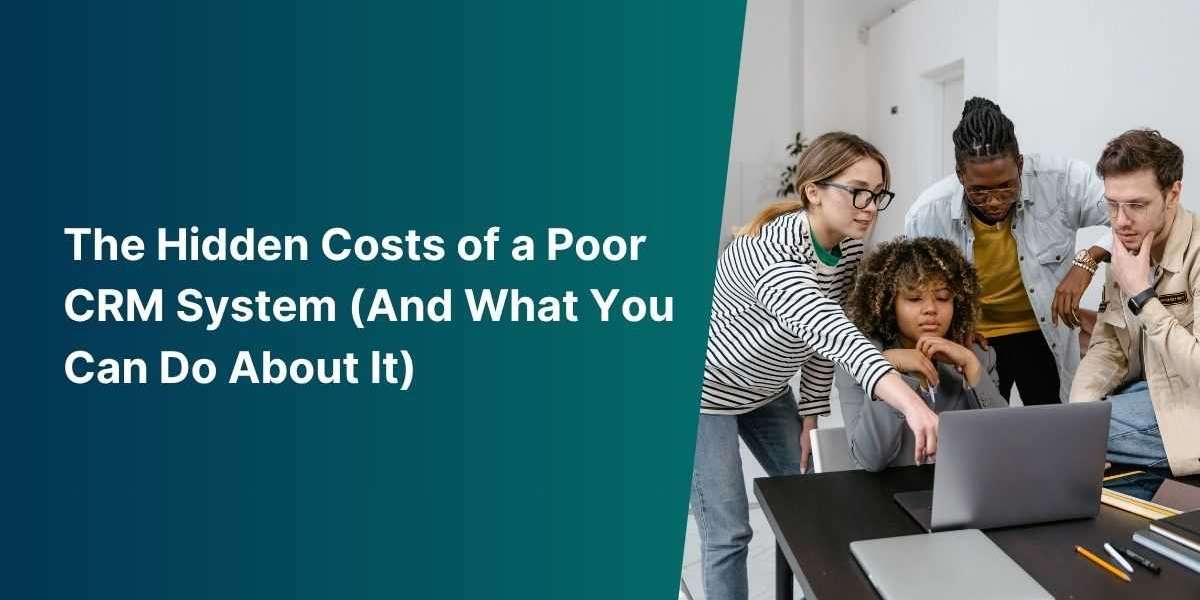Customer Relationship Management (CRM) systems play a critical role in today’s business environment. A well-implemented CRM can help companies maintain detailed customer records, automate sales processes, and improve communication across departments. However, many businesses use CRM systems that do not meet their needs, causing more problems than they solve.
Recent research by Nucleus Research shows that for every dollar spent on CRM software, companies typically see a return of $8.71. Yet, when a CRM system is poorly designed or implemented, this return diminishes sharply. According to CSO Insights, 43% of CRM implementations fail to meet organizational expectations, leading to hidden costs that often go unnoticed.
These hidden costs affect not only revenue but also employee productivity, customer satisfaction, and operational efficiency. This article explores these costs in detail and provides technical and practical insights on how businesses can resolve them through crm software development services and partnerships with a professional CRM Software Development Company.
What Defines a Poor CRM System?
A CRM system becomes poor when it cannot support the business effectively. Some common traits of such systems include:
Unreliable or outdated data: Inaccurate customer information leads to poor decision-making.
Difficult-to-use interface: Employees resist using complex or unintuitive software.
Limited integration: CRM does not connect with other essential business tools, causing silos.
Slow performance and frequent downtime: These issues disrupt workflows and cause frustration.
Inflexible structure: The system cannot adapt to unique business processes or scale with growth.
Identifying these signs early can prevent the escalation of hidden costs.
Hidden Costs of a Poor CRM System
1. Lost Sales and Revenue
Sales teams rely heavily on CRM data to track leads, opportunities, and customer interactions. When the CRM contains incomplete or incorrect information, the result is missed sales and lost revenue.
Causes and Consequences
Missed follow-ups: When the CRM does not provide timely reminders or contact details, sales reps forget to follow up with prospects. According to Salesforce, 79% of marketing leads never convert into sales due to lack of effective follow-up.
Poor lead prioritization: Without reliable data, reps waste time on low-potential leads instead of focusing on promising ones.
Delayed sales cycles: Manual and redundant processes within a poor CRM slow down closing deals.
| Impact Area | Description | Estimated Cost (Industry Averages) |
|---|---|---|
| Missed leads | Leads fall through cracks due to poor tracking | 20-30% revenue loss annually |
| Inefficient sales | Wasting time on low-value prospects | 15-25% reduced sales productivity |
| Slow deal closure | Lengthy sales cycles | 10-15% higher sales costs |
2. Reduced Employee Productivity
CRM systems that are difficult to navigate or prone to errors cause employees to spend more time than necessary on administrative tasks.
Common Productivity Issues
Duplicate data entry: Sales and marketing teams may enter the same information multiple times due to lack of integration.
Training challenges: Complex interfaces increase onboarding time for new employees.
Manual reporting: Lack of automation forces staff to create reports manually, reducing time spent on strategic work.
According to Forrester, employees can lose up to 30% of their productive time due to inefficient software systems.
3. Poor Customer Experience
A CRM system that cannot provide accurate, real-time information leads to inconsistent or delayed customer service.
Effects on Customers
Customers receive conflicting information from different departments.
Customer requests take longer to resolve due to missing data.
Businesses fail to personalize communications or anticipate customer needs.
PwC’s customer experience report states that 32% of consumers stop doing business with a company after a single bad experience.
4. Increased IT and Maintenance Costs
Maintaining an ineffective CRM system can strain IT resources.
Typical IT Challenges
Frequent system downtime causing lost business hours.
Increased technical support requirements.
Costly custom fixes and patches.
Hardware upgrades to support outdated software.
These problems often lead companies to spend disproportionately on IT rather than strategic initiatives.
5. Compliance and Security Risks
CRM systems handle sensitive customer data. Poorly designed or unsupported systems may lack adequate security controls.
Potential Risks Include
Non-compliance with GDPR, CCPA, or HIPAA regulations.
Data breaches exposing personal customer information.
Loss of customer trust and subsequent business damage.
Legal fines and penalties.
According to IBM, the average cost of a data breach reached $4.45 million in 2023.
How to Identify These Costs in Your Organization
Steps to Conduct a CRM Audit
Assess Data Quality: Check for duplicates, outdated records, and incomplete fields.
Evaluate User Adoption: Survey employees for feedback and review system usage logs.
Review Integration Points: Identify disconnected systems causing manual work.
Test System Performance: Measure downtime, load times, and error rates.
Audit Security Controls: Verify encryption, access controls, and compliance reports.
This audit helps reveal inefficiencies and quantify their impact.
What You Can Do: Practical Solutions
Custom CRM Development
Many CRM challenges stem from the limitations of off-the-shelf software. Partnering with a CRM Software Development Company offers an alternative: build a custom solution tailored to your business.
Benefits include:
Tailored workflows: Software adapts to your exact processes.
Deep integration: Connects seamlessly with ERP, marketing automation, and finance tools.
Scalable architecture: Grows with your company’s needs.
Improved user experience: Simplified interfaces increase adoption.
Robust security: Industry-specific security protocols to ensure compliance.
Choosing the Right CRM Software Development Services
Look for providers who offer:
| Feature | Why It Matters |
|---|---|
| Proven CRM development expertise | Ensures quality and reliability |
| Strong API and integration skills | Enables connecting existing systems |
| Agile development approach | Allows for iterative improvements and flexibility |
| Security-first mindset | Protects sensitive customer data |
| Post-launch support | Guarantees ongoing maintenance and enhancements |
Training and Change Management
A good CRM fails if employees do not use it effectively. Develop comprehensive training programs focused on real-world tasks. Regular refresher sessions help sustain adoption and proficiency.
Process Automation
Use your CRM to automate repetitive tasks such as:
Lead assignment and scoring
Follow-up reminders and notifications
Customer feedback collection
Report generation and data backups
Automation reduces manual errors and frees up time for strategic activities.
Regular Maintenance and Upgrades
Schedule periodic updates and system reviews to keep your CRM current. Address bugs, update security patches, and incorporate user feedback to improve functionality.
Technical Considerations for CRM Software Development
Architecture Essentials
| Component | Role |
|---|---|
| Database | Secure storage of customer data |
| Application Logic | Implements business rules and workflows |
| Integration Layer | Connects CRM with other enterprise systems via APIs |
| User Interface | Provides easy access through web and mobile apps |
| Security Layer | Controls access, encrypts data, and logs activity |
Key Features to Request
Custom Fields Modules: Adapt CRM to your data requirements.
Real-Time Data Sync: Keeps customer info current across platforms.
Role-Based Access Control: Protects sensitive data.
Reporting Dashboards: Gives visibility into sales and marketing metrics.
Mobile Access: Supports remote teams and field agents.
Case Study: Manufacturing Firm Solves CRM Issues with Custom Solution
Background
A mid-sized manufacturing firm used an outdated CRM system that frequently crashed. Sales reps lacked reliable lead data, and support teams struggled to track customer complaints.
Solution
The firm engaged a CRM software development company to design a custom CRM platform. The new system featured:
Integration with their ERP and order management systems.
Automated lead scoring and assignment.
Intuitive dashboards tailored for sales and support teams.
Role-based access to ensure security.
Results
25% faster sales cycle.
15% increase in customer satisfaction.
30% reduction in IT support costs related to CRM.
Conclusion
Poor CRM systems carry hidden costs that impact revenue, efficiency, and customer loyalty. Addressing these challenges requires a strategic approach including thorough evaluation, custom development, and ongoing maintenance.
By working with specialized crm software development services and a trusted CRM Software Development Company, businesses can design CRM solutions tailored to their workflows and goals. Such systems improve data quality, user adoption, and integration, reducing hidden costs and supporting sustainable growth.
Taking a proactive stance on CRM management transforms a costly problem into a competitive advantage.













